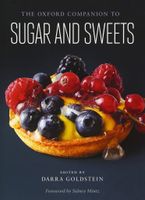Historical Background
Published 2015
The earliest Indian sweet dishes were flavored with honey, dates, and fruits. The first sweet mentioned in the Sanskrit literature around 1000 b.c.e. is apupa, a round cake made of barley or rice flour baked in ghee and sweetened with honey. There are also references to ksira, milk and boiled rice, the ancestor of modern rice puddings.
Sugarcane grew in India from ancient times. Originally it was chewed, but during the first millennium b.c.e. Indians began to convert it to various products. The stems were crushed in a machine called a yantra, a large mortar and pestle turned by oxen that is still used in rural areas. The extracted juice, which contains up to 17 percent sucrose, was filtered and cooked slowly in a large metal pot fueled by the cane stalks. The thickened juice, called phanita, was similar to molasses and further concentrated and dried to make solid pieces of brown sugar, known as jaggery or gur. (The English word “sugar” comes from sarkara, the Sanskrit word for jaggery.) In the third century b.c.e., Indians discovered the technique of refining the juice into crystals, called khand (the origin of the English word “candy”). The Greek ambassador and writer Megasthenes (ca. 350–290 b.c.e.) was amazed by the sight of “tall reeds which are sweet both by nature and by concoction”—sugarcane, not known in Europe at the time—and “stones the colour of frankincense, sweeter than figs or honey.” See sugarcane agriculture and sugar refining.
Become a Premium Member to access this page
Unlimited, ad-free access to hundreds of the world’s best cookbooks
Over 160,000 recipes with thousands more added every month
Recommended by leading chefs and food writers
Powerful search filters to match your tastes
Create collections and add reviews or private notes to any recipe
Swipe to browse each cookbook from cover-to-cover
Manage your subscription via the My Membership page
Part of
Advertisement
Related Recipes
-
-
-
-
Related Reference
-
-
-
-
Advertisement



